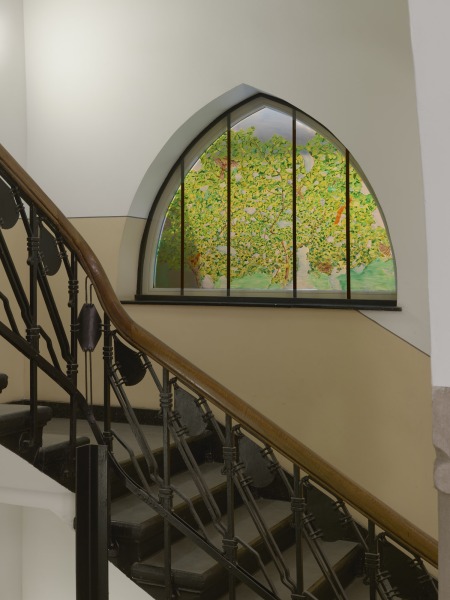Installation for Soteria in St. Hedwig Hospital in Berlin
Concept
During psychosis, thoughts remain isolated in an abstract, virtual space. What reconnects patients to the immediate real space, to the concrete materiality that surrounds them? What keeps patients and staff together as a therapeutic community? With the site-specific work in the Soteria at St. Hedwig Hospital, I would like to encourage patients’ contact with their immediate material surroundings and thereby support the therapeutic process. The references to nature that every patient in the Soteria can quickly recognise (the plane tree in the courtyard, and the therapeutic garden) create orientation and make the patients feel welcome in their new everyday life. It also became clear that the plane tree is an important common reference point for the therapeutic community of the Soteria. With a worm’s-eye perspective, from the bottom up, the focus is on a feeling of contact with the ground, which is often lost during psychosis, and a hopeful attitude is encouraged. Like the «thin skinned» feeling of a psychosis, the transparent support of the paintings creates continuity between the observer and the observed: people can see the painting process as it is being carried out from the other side of the painting. This creates an interaction between interior and exterior space, between individual and collective perception, between the inner mental state and the common experience.
Process
On-site watercolour painting
I first spent several months making watercolours on-site in the courtyard of St. Hedwig Hospital. This enabled me to see where patients usually meet and which elements of the environment have a special meaning for them. Through an online survey, these first watercolours were presented to former patients from the Soteria Association. In addition, two meetings with the team took place on-site at the Soteria. The patients made a clear choice for the motif of the plane tree, a large tree near the old Soteria, which radiates peace for them and with which they felt very connected. Some patients remembered lying under the tree and relaxing there. The patients and the team chose the garden as the second motif for the smaller picture and a detail of the plane tree as the motif for the glass window.
Preliminary drawing
Following this research, I made preliminary drawings directly onto the silk-covered stretcher frames on-site at St. Hedwig Hospital: I drew the tree while lying down, observing it through the transparent organza silk, and the garden while sitting down. The large stretcher frame was the same size as the historical window, the smaller stretcher frame was proportionally smaller.
Painting process
The paintings Platane and Garten were executed in my studio with glazes of several layers. For this I translated the SCN colour system used by Jason Danziger for the Soteria interior design into my own colour system (self-made oil paints produced with pigment powders). The main colours are bismuth yellow medium, cobalt blue and natural umber. New colour variations are thus introduced to the room, but they are coherent with the overall colour concept. A former patient saw the work in process in my studio and was quickly able to recognise the locations. When another patient looked at the plane tree painting, he said that he felt transported to underneath the tree.
The stained glass window was removed from its original location and painted directly in the art room of the old Soteria. For this, I used ready-mixed transparent and semi-transparent oil paints. The main colours were yellow 101, phthalo blue, phthalo green and dioxazine. I often returned to observe the tree during the painting process, continually adding new details to the painting. Both the staff and some in-patients saw the work in progress. As I decided to work on the contrast in the painting, a patient commented in the same moment on exactly this point.
Installation
In the milieu room, where people meet and eat in the soteria, the painting of the plane tree was installed on the wall and lit from behind with LED tubes. The lighting was designed by Rosenspieß lighting design in collaboration with Jason Danziger. The painting thus conceptually acts as a window, bringing the viewer into contact with a poetic and contemplative view. The garden painting was hung on the wall in the alcove room where therapeutic conversations take place. The stained glass window was installed in the area between the staircase and the waiting room for outpatients, emphasising the arches which are a historical architectural feature of the hospital.





